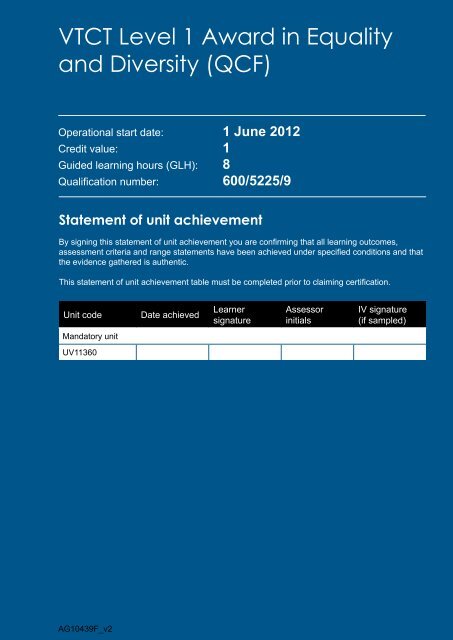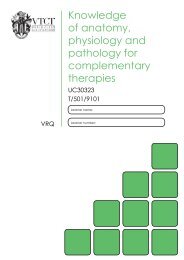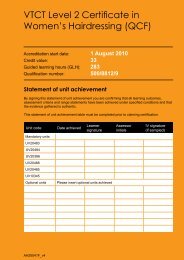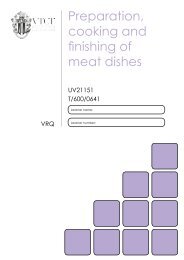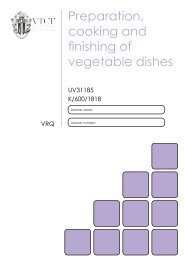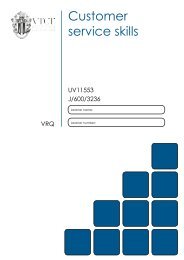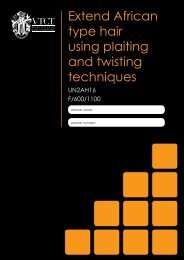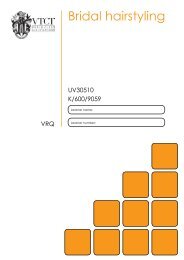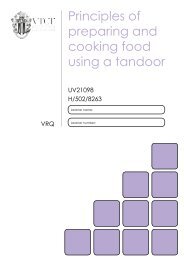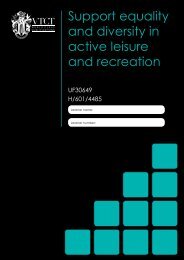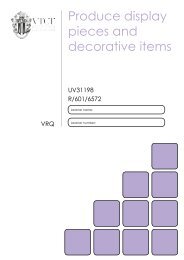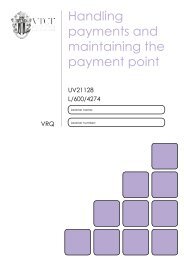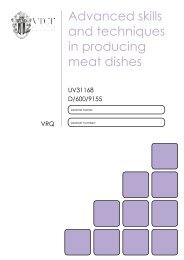VTCT Level 1 Award in Equality and Diversity - Qualification Title ...
VTCT Level 1 Award in Equality and Diversity - Qualification Title ...
VTCT Level 1 Award in Equality and Diversity - Qualification Title ...
Create successful ePaper yourself
Turn your PDF publications into a flip-book with our unique Google optimized e-Paper software.
<strong>VTCT</strong> <strong>Level</strong> 1 <strong>Award</strong> <strong>in</strong> <strong>Equality</strong><br />
<strong>and</strong> <strong>Diversity</strong> (QCF)<br />
Operational start date: 1 June 2012<br />
Credit value:<br />
1<br />
Guided learn<strong>in</strong>g hours (GLH): 8<br />
<strong>Qualification</strong> number: 600/5225/9<br />
Statement of unit achievement<br />
By sign<strong>in</strong>g this statement of unit achievement you are confirm<strong>in</strong>g that all learn<strong>in</strong>g outcomes,<br />
assessment criteria <strong>and</strong> range statements have been achieved under specified conditions <strong>and</strong> that<br />
the evidence gathered is authentic.<br />
This statement of unit achievement table must be completed prior to claim<strong>in</strong>g certification.<br />
Unit code Date achieved<br />
M<strong>and</strong>atory unit<br />
UV11360<br />
AG10439F_v2<br />
Learner<br />
signature<br />
Assessor<br />
<strong>in</strong>itials<br />
IV signature<br />
(if sampled)
2<br />
The qualification<br />
Introduction<br />
The <strong>VTCT</strong> <strong>Level</strong> 1 <strong>Award</strong> <strong>in</strong> <strong>Equality</strong> <strong>and</strong><br />
<strong>Diversity</strong> (QCF) can be delivered <strong>in</strong> a variety<br />
of contexts, whether it be as part of a summer<br />
school or <strong>in</strong>duction programme, enrichment or<br />
staff CPD.<br />
This qualification will develop your knowledge<br />
<strong>and</strong> underst<strong>and</strong><strong>in</strong>g of the concepts of equality,<br />
diversity <strong>and</strong> stereotyp<strong>in</strong>g. You will explore<br />
various approaches that promote equality <strong>and</strong><br />
diversity <strong>and</strong> describe different ways that you<br />
<strong>and</strong> your organisation can positively support<br />
equality, diversity <strong>and</strong> <strong>in</strong>clusion.<br />
Prerequisites<br />
There are no formal prerequisite qualifications<br />
that you must have prior to undertak<strong>in</strong>g this<br />
qualification.<br />
Your centre will have ensured that you have<br />
the required knowledge, underst<strong>and</strong><strong>in</strong>g <strong>and</strong><br />
skills to enrol <strong>and</strong> successfully achieve this<br />
qualification.
Progression<br />
<strong>Equality</strong>, diversity <strong>and</strong> <strong>in</strong>clusion are key<br />
priorities of many organisations <strong>in</strong> today’s<br />
society.<br />
This qualification will provide you with the<br />
knowledge <strong>and</strong> underst<strong>and</strong><strong>in</strong>g to contribute<br />
to your organisation’s equality <strong>and</strong> diversity<br />
objectives.<br />
3
4<br />
<strong>Qualification</strong> structure<br />
Total credits required - 1<br />
All m<strong>and</strong>atory units must be completed.<br />
M<strong>and</strong>atory unit - 1 credit<br />
<strong>VTCT</strong> unit<br />
code<br />
Ofqual unit<br />
reference<br />
Unit title Credit value GLH<br />
UV11360 K/503/7496 Valu<strong>in</strong>g equality <strong>and</strong> diversity <strong>in</strong> society 1 8
Guidance on assessment<br />
This book conta<strong>in</strong>s the m<strong>and</strong>atory units that make up this qualification. Optional units will be<br />
provided <strong>in</strong> additional booklets (if applicable). Where <strong>in</strong>dicated, <strong>VTCT</strong> will provide assessment<br />
materials. Assessments may be <strong>in</strong>ternal or external. The method of assessment is <strong>in</strong>dicated <strong>in</strong><br />
each unit.<br />
Internal assessment<br />
(any requirements will be shown <strong>in</strong> the unit)<br />
Assessment is set, marked <strong>and</strong> <strong>in</strong>ternally<br />
verified by the centre to clearly demonstrate<br />
achievement of the learn<strong>in</strong>g outcomes.<br />
Assessment is sampled by <strong>VTCT</strong> external<br />
verifiers.<br />
External assessment<br />
(any requirements will be shown <strong>in</strong> the unit)<br />
Externally assessed question papers<br />
completed electronically will be set <strong>and</strong> marked<br />
by <strong>VTCT</strong>.<br />
Externally assessed hard-copy question papers<br />
will be set by <strong>VTCT</strong>, marked by centre staff <strong>and</strong><br />
sampled by <strong>VTCT</strong> external verifiers.<br />
Assessment expla<strong>in</strong>ed<br />
<strong>VTCT</strong> qualifications are assessed <strong>and</strong> verified<br />
by centre staff. Work will be set to improve your<br />
practical skills, knowledge <strong>and</strong> underst<strong>and</strong><strong>in</strong>g.<br />
For practical elements, you will be observed<br />
by your assessor. All your work must be<br />
collected <strong>in</strong> a portfolio of evidence <strong>and</strong> crossreferenced<br />
to requirements listed <strong>in</strong> this record<br />
of assessment book.<br />
Your centre will have an <strong>in</strong>ternal verifier whose<br />
role is to check that your assessment <strong>and</strong><br />
evidence is valid <strong>and</strong> reliable <strong>and</strong> meets <strong>VTCT</strong><br />
<strong>and</strong> regulatory requirements.<br />
An external verifier, appo<strong>in</strong>ted by <strong>VTCT</strong>, will<br />
visit your centre to sample <strong>and</strong> quality-check<br />
assessments, the <strong>in</strong>ternal verification process<br />
<strong>and</strong> the evidence gathered. You may be<br />
asked to attend on a different day from usual if<br />
requested by the external verifier.<br />
This record of assessment book is your<br />
property <strong>and</strong> must be <strong>in</strong> your possession when<br />
you are be<strong>in</strong>g assessed or verified. It must be<br />
kept safe. In some cases your centre will be<br />
required to keep it <strong>in</strong> a secure place. You <strong>and</strong><br />
your course assessor will together complete<br />
this book to show achievement of all learn<strong>in</strong>g<br />
outcomes, assessment criteria <strong>and</strong> ranges.<br />
5
6<br />
Creat<strong>in</strong>g a portfolio of evidence<br />
As part of this qualification you are required to<br />
produce a portfolio of evidence. A portfolio will<br />
confirm the knowledge, underst<strong>and</strong><strong>in</strong>g <strong>and</strong> skills<br />
that you have learnt. It may be <strong>in</strong> electronic or<br />
paper format.<br />
Your assessor will provide guidance on how to<br />
prepare the portfolio of evidence <strong>and</strong> how to<br />
show practical achievement, <strong>and</strong> underst<strong>and</strong><strong>in</strong>g<br />
of the knowledge required to successfully<br />
complete this qualification. It is this booklet<br />
along with the portfolio of evidence that will<br />
serve as the prime source of evidence for this<br />
qualification.<br />
Evidence <strong>in</strong> the portfolio may take the follow<strong>in</strong>g<br />
forms:<br />
• Observed work<br />
• Witness statements<br />
• Audio-visual media<br />
• Evidence of prior learn<strong>in</strong>g or atta<strong>in</strong>ment<br />
• Written questions<br />
• Oral questions<br />
• Assignments<br />
• Case studies<br />
All evidence should be documented <strong>in</strong> the<br />
portfolio <strong>and</strong> cross referenced to unit outcomes.<br />
Construct<strong>in</strong>g the portfolio of evidence should not<br />
be left to the end of the course.<br />
Many frequently asked questions <strong>and</strong> other<br />
useful <strong>in</strong>formation are detailed <strong>in</strong> the <strong>VTCT</strong><br />
C<strong>and</strong>idate’s H<strong>and</strong>book, which is available on<br />
the <strong>VTCT</strong> website at www.vtct.org.uk/students.<br />
Other questions should be addressed to the<br />
tutor, lecturer or assessor.
Unit assessment methods<br />
This section provides an overview of the assessment methods that make up each unit <strong>in</strong> this<br />
qualification. Detailed <strong>in</strong>formation on assessment is provided <strong>in</strong> each unit.<br />
M<strong>and</strong>atory unit<br />
<strong>VTCT</strong> unit<br />
code<br />
UV11360<br />
Unit title<br />
Valu<strong>in</strong>g equality <strong>and</strong> diversity <strong>in</strong><br />
society<br />
External Internal<br />
Question<br />
paper(s)<br />
Observation(s)<br />
Portfolio of<br />
evidence<br />
0 û <br />
7
8<br />
Unit glossary<br />
<strong>VTCT</strong> product<br />
code<br />
Description<br />
All units are allocated a unique <strong>VTCT</strong> product code for identification purposes.<br />
This code should be quoted <strong>in</strong> all queries <strong>and</strong> correspondence to <strong>VTCT</strong>.<br />
Unit title The title clearly <strong>in</strong>dicates the focus of the unit.<br />
National<br />
Occupational<br />
St<strong>and</strong>ards<br />
(NOS)<br />
<strong>Level</strong><br />
Credit value<br />
Guided<br />
learn<strong>in</strong>g hours<br />
(GLH)<br />
Observations<br />
Learn<strong>in</strong>g<br />
outcomes<br />
Evidence<br />
requirements<br />
Observation<br />
outcome<br />
Knowledge<br />
outcome<br />
Assessment<br />
criteria<br />
Range<br />
NOS describe the skills, knowledge <strong>and</strong> underst<strong>and</strong><strong>in</strong>g needed to undertake a<br />
particular task or job to a nationally recognised level of competence.<br />
<strong>Level</strong> is an <strong>in</strong>dication of the dem<strong>and</strong> of the learn<strong>in</strong>g experience, the depth<br />
<strong>and</strong>/or complexity of achievement <strong>and</strong> <strong>in</strong>dependence <strong>in</strong> achiev<strong>in</strong>g the<br />
learn<strong>in</strong>g outcomes. There are 9 levels of achievement with<strong>in</strong> the <strong>Qualification</strong>s<br />
<strong>and</strong> Credit Framework (QCF).<br />
This is the number of credits awarded upon successful achievement of all unit<br />
outcomes. Credit is a numerical value that represents a means of recognis<strong>in</strong>g,<br />
measur<strong>in</strong>g, valu<strong>in</strong>g <strong>and</strong> compar<strong>in</strong>g achievement.<br />
GLH is an estimate of the time allocated to teach, <strong>in</strong>struct, assess <strong>and</strong><br />
support learners throughout a unit. Learner <strong>in</strong>itiated private study, preparation<br />
<strong>and</strong> mark<strong>in</strong>g of formative assessment is not taken <strong>in</strong>to account.<br />
This <strong>in</strong>dicates the m<strong>in</strong>imum number of observations required to achieve the<br />
unit.<br />
The learn<strong>in</strong>g outcomes are the most important component of the unit, they set<br />
out what is expected <strong>in</strong> terms of know<strong>in</strong>g, underst<strong>and</strong><strong>in</strong>g <strong>and</strong> practical<br />
ability as a result of the learn<strong>in</strong>g process. Learn<strong>in</strong>g outcomes are the results<br />
of learn<strong>in</strong>g.<br />
This section provides guidel<strong>in</strong>es on how evidence must be gathered.<br />
An observation outcome details the practical tasks that must be completed to<br />
achieve the unit.<br />
A knowledge outcome details the theoretical requirements of a unit that must<br />
be evidenced through oral question<strong>in</strong>g, a m<strong>and</strong>atory written question paper or<br />
portfolio of evidence.<br />
Assessment criteria set out what is required, <strong>in</strong> terms of achievement, to meet<br />
a learn<strong>in</strong>g outcome. The assessment criteria <strong>and</strong> learn<strong>in</strong>g outcomes are the<br />
components that <strong>in</strong>form the learn<strong>in</strong>g <strong>and</strong> assessment that should take place.<br />
Assessment criteria def<strong>in</strong>e the st<strong>and</strong>ard expected to meet learn<strong>in</strong>g outcomes.<br />
The range <strong>in</strong>dicates what must be covered. Ranges must be practically<br />
demonstrated <strong>in</strong> parallel to the unit’s observation outcomes.
UV11360<br />
Valu<strong>in</strong>g equality <strong>and</strong> diversity <strong>in</strong><br />
society<br />
The aim of this unit is to develop your knowledge <strong>and</strong><br />
underst<strong>and</strong><strong>in</strong>g of equality <strong>and</strong> diversity, <strong>and</strong> of the ways <strong>in</strong><br />
which it can be positively supported by society.<br />
UV11360_v4
<strong>Level</strong><br />
Credit value<br />
GLH<br />
1<br />
1<br />
8<br />
External paper(s)<br />
0
Valu<strong>in</strong>g equality <strong>and</strong> diversity <strong>in</strong><br />
society<br />
Learn<strong>in</strong>g outcomes Evidence requirements<br />
On completion of this unit you will:<br />
1. Underst<strong>and</strong> what is meant by diversity <strong>and</strong><br />
appreciate its value to society<br />
2. Underst<strong>and</strong> what is meant by stereotyp<strong>in</strong>g<br />
<strong>and</strong> its underly<strong>in</strong>g assumptions <strong>and</strong><br />
generalisations<br />
3. Underst<strong>and</strong> the concept of equal<br />
opportunities<br />
4. Be able to recognise positive approaches<br />
that promote equality <strong>and</strong> diversity<br />
1. Achiev<strong>in</strong>g outcomes<br />
All outcomes must be achieved <strong>and</strong><br />
evidenced <strong>in</strong> your portfolio of evidence.<br />
Evidence may <strong>in</strong>clude practical observed<br />
work, witness statements, audiovisual<br />
media, projects, assignments, case studies,<br />
reflective accounts, oral/written question<strong>in</strong>g<br />
<strong>and</strong>/or other forms of evidence.<br />
2. Tutor/Assessor guidance<br />
You will be guided by your tutor/assessor<br />
on how to achieve learn<strong>in</strong>g outcomes <strong>in</strong><br />
this unit. All assessment criteria must be<br />
evidenced.<br />
UV11360 11
12<br />
Outcome 1<br />
UV11360<br />
Outcomes<br />
Underst<strong>and</strong> what is meant by diversity <strong>and</strong> appreciate its value<br />
to society<br />
You can:<br />
a. Give examples of at least three diverse<br />
social groups<br />
b. Describe ways <strong>in</strong> which their differences<br />
have made a positive contribution to<br />
society<br />
Description of<br />
evidence<br />
Portfolio<br />
reference
Outcome 2<br />
Underst<strong>and</strong> what is meant by stereotyp<strong>in</strong>g <strong>and</strong> its underly<strong>in</strong>g<br />
assumptions <strong>and</strong> generalisations<br />
You can:<br />
a. Outl<strong>in</strong>e examples of stereotyp<strong>in</strong>g<br />
different groups of people<br />
b. Describe different ways <strong>in</strong> which<br />
stereotyp<strong>in</strong>g contributes to negative<br />
attitudes <strong>and</strong> bias<br />
Description of<br />
evidence<br />
Portfolio<br />
reference<br />
UV11360 13
14<br />
Outcome 3<br />
Underst<strong>and</strong> the concept of equal opportunities<br />
You can:<br />
a. Describe what an equal opportunities<br />
policy sets out to achieve<br />
b. Outl<strong>in</strong>e ways <strong>in</strong> which an equal<br />
opportunities policy promotes <strong>in</strong>clusion<br />
UV11360<br />
Description of<br />
evidence<br />
Portfolio<br />
reference
Outcome 4<br />
Be able to recognise positive approaches that promote equality<br />
<strong>and</strong> diversity<br />
You can:<br />
a. Describe different ways <strong>in</strong> which an<br />
<strong>in</strong>dividual or an organisation can<br />
positively support equality <strong>and</strong> diversity<br />
Description of<br />
evidence<br />
Portfolio<br />
reference<br />
UV11360 15
16<br />
Unit content<br />
This section provides guidance on the recommended knowledge <strong>and</strong> skills required to enable you<br />
to achieve each of the learn<strong>in</strong>g outcomes <strong>in</strong> this unit. Your tutor/assessor will ensure you have the<br />
opportunity to cover all of the unit content.<br />
Outcome 1: Underst<strong>and</strong> what is meant by diversity <strong>and</strong> appreciate its value<br />
to society<br />
Diverse social groups: Age (e.g. older<br />
adults), race (e.g. Asian), gender (e.g.<br />
female), religion (e.g. Muslim), disability<br />
(e.g. physical impairment), sexual<br />
orientation (e.g. gay).<br />
Positive contribution to society: Young<br />
people undertak<strong>in</strong>g voluntary work,<br />
ethnic m<strong>in</strong>orities rais<strong>in</strong>g awareness of<br />
their culture, female employment <strong>and</strong><br />
develop<strong>in</strong>g equality <strong>in</strong> the workplace,<br />
religious ethos <strong>and</strong> car<strong>in</strong>g attitudes towards<br />
others, <strong>in</strong>creas<strong>in</strong>g participation of people<br />
with disabilities <strong>in</strong> sports, raised awareness<br />
<strong>and</strong> acceptance of sexual orientation. (This<br />
list is not exhaustive.)<br />
Outcome 2: Underst<strong>and</strong> what is meant by stereotyp<strong>in</strong>g <strong>and</strong> its underly<strong>in</strong>g<br />
assumptions <strong>and</strong> generalisations<br />
Stereotyp<strong>in</strong>g different groups: ‘Hoodies’<br />
are trouble makers, African Americans are<br />
the best athletes, people with disabilities<br />
are unable work, men are stronger<br />
than women, effem<strong>in</strong>ate men are gay,<br />
football fans are hooligans (this list is not<br />
exhaustive).<br />
Contribution of stereotyp<strong>in</strong>g:<br />
Stereotypes change our perceptions <strong>and</strong><br />
op<strong>in</strong>ions of social groups, stereotypes<br />
affect our judgement about others,<br />
stereotypes can lead to unfair treatment<br />
(e.g. employment opportunities, life<br />
opportunities).<br />
UV11360
Outcome 3: Underst<strong>and</strong> the concept of equal opportunities<br />
Equal opportunities policy: To provide<br />
equality of opportunity <strong>and</strong> fairness for all<br />
regardless of gender/marital status/race/<br />
ethnic orig<strong>in</strong>/nationality/national orig<strong>in</strong>/<br />
disability/sexual orientation/religion/age,<br />
to avoid unfair discrim<strong>in</strong>ation, to act as a<br />
reference po<strong>in</strong>t <strong>in</strong> the event of dispute.<br />
Ways equal opportunities policy<br />
promotes <strong>in</strong>clusion: Def<strong>in</strong>es rights <strong>and</strong><br />
responsibilities, promotes fair <strong>and</strong> dignified<br />
treatment, elim<strong>in</strong>ates discrim<strong>in</strong>ation, values<br />
contributions from everyone, removes<br />
barriers to participation.<br />
Outcome 4: Be able to recognise positive approaches that promote equality<br />
<strong>and</strong> diversity<br />
Positively support<strong>in</strong>g equality <strong>and</strong><br />
diversity: Individual (e.g. acceptance of<br />
differences, ignor<strong>in</strong>g stereotypes, respect<br />
for others, embrac<strong>in</strong>g positive contribution<br />
of diverse groups, volunteer<strong>in</strong>g to work<br />
with diverse groups), organisation (e.g.<br />
equal opportunities policy, <strong>in</strong>clusion policy,<br />
equal employment opportunities <strong>and</strong><br />
pay, reasonable adjustments, removal of<br />
barriers, support a culture of fairness <strong>and</strong><br />
respect for others).<br />
UV11360 17
18<br />
UV11360<br />
Notes<br />
Use this area for mak<strong>in</strong>g notes <strong>and</strong> draw<strong>in</strong>g diagrams


